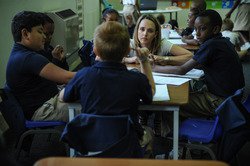Hiring Teachers for Their Potential in South African Blended Learning Schools
Guest post by Bailey Thomson, Director of School Design for SPARK Schools.
I had the privilege of beginning my career in education at Rocketship, where I found that even in Silicon Valley’s bustling education start-up scene, our model was unusual and often difficult to understand to those outside of our school network. Now, as director of school design for SPARK Schools, a blended learning primary school network in South Africa, I find that inquisitive looks and head scratching are even more common. South Africa’s education reform movement is just beginning, and there are very few players in education technology and innovative school networks. Ours are the first primary schools employing a blended learning model on the African continent, so we are tasked with explaining the value-add of blended learning to the students and families we seek to enroll, to the educators we seek to recruit, and to the South African education community at large.
Which brings me to one of our significant challenges: humans. Though my primary responsibility is in design of our education model, I understand and am invested in the importance of recruiting and selecting the very best educators to implement our model effectively. However, we find it tremendously difficult to source the sort of community-responsive, dynamic school leaders, teachers, and tutors who have and will be able to drive high expectations in our students. Alternative teacher certification programs do not yet exist in South Africa and bachelor of education degrees do not prepare teaching candidates adequately for the unique challenges of South African education. A recent report by the Centre for Development and Enterprise on teacher supply and demand in South Africa stated, “Not all qualified teachers are competent professionals able to provide quality teaching and learning. It is common cause that the quality of most ITE [initial teacher education] programmes leaves a lot to be desired and the result is that most of the current teaching force has been inadequately educated and trained, whether during apartheid or in the recent past.”
Therefore, understanding that the need for high quality education in South Africa is urgent, we have adopted a recruitment and selection strategy at SPARK that focuses more on hiring for potential than on hiring for current capability. As we pursue this strategy, we understand that after selection of educators, the burden is on the organization to provide substantial professional development so that our school leaders, teachers, and tutors are well equipped to serve our SPARK scholars. After joining SPARK, our educators receive more than 250 hours per year of professional development in the form of pre-service training, weekly professional development, observation and coaching, and differentiated leadership development. But first, what do we look for as we recruit and interview? These are the four core characteristics we look for in every stage of our selection process, which allowed us to whittle 3,000 submitted resumes to 40 excellent hires in 2014:
- Mission Alignment: Does the candidate truly believe and is the candidate able to demonstrate commitment to the belief that all children should have access to high quality education? Do they feel a sense of personal responsibility to bettering education for all South Africans? We measure mission alignment through initial resume screening and phone interviews, through a Mission and Vision interview session with our CEO and COO, and by observing and evaluating the educator’s behaviour management techniques during a sample lesson.
- Excellence: Has the candidate previously demonstrated excellence and achievement in a significant area of their life? Can the candidate articulate what excellence would look like in their school or classroom? Does the candidate prioritize academic achievement for their students? We measure excellence through initial resume screening, a general interview with our director of leadership and development, and by observing and evaluating the educator’s execution of instruction during a sample lesson.
- Grit: Has the candidate previously demonstrated persistence through challenge? Can the candidate articulate how they would approach a challenge in the SPARK Schools environment, with a particular student, or in interaction with a colleague? We measure grit primarily in our Mission and Vision session with our CEO and COO and our general interview with our director of leadership and develoment through role plays, imaginary situations, and discussion of the candidate’s past.
- Self-Reflection: How does the candidate claim to receive constructive feedback from colleagues, managers, students, and parents? Can the candidate articulate their strengths and areas of growth, as well as steps they have taken to better themselves professionally and personally? Does the candidate seek out feedback actively and seem excited about the prospect of observation and coaching? We measure self-reflection during the feedback session following the candidate’s sample lesson, as well as with strategic questions in our general interview and Mission and Vision sessions.
Ours is a lengthy interview process, particularly by the standards of South African schools, and we are still attempting to perfect how we authentically and accurately evaluate each of these areas. I cannot think of a more important function for our organizational leaders at this time, however, as we nurture our network’s culture. Consistent selection of exceptional staff will allow us to serve South African students and their families well as we lead a revolution in South African education.
to perfect how we authentically and accurately evaluate each of these areas. I cannot think of a more important function for our organizational leaders at this time, however, as we nurture our network’s culture. Consistent selection of exceptional staff will allow us to serve South African students and their families well as we lead a revolution in South African education.
Bailey Thomson is the Director of School Design for SPARK Schools, a network of blended learning primary schools based on Johannesburg, South Africa. In her role, Bailey is responsible for the design and implementation of the network’s blended learning model and academic program. Bailey graduated from the College of William and Mary in 2010 with double majors in Government and Middle Eastern Studies and taught at Rocketship Education as a Teach For America corps member until 2012.



As an independent school who are open to innovative education concepts, blended learning might work for a school that offers remedial education and special needs. Thank you for sharing on the urgency to have a education model developed by professionals like yourself.
Now try to play this new latest version game get robux free it is very much and skill based game.